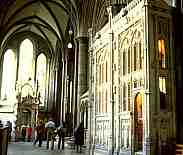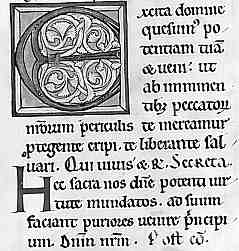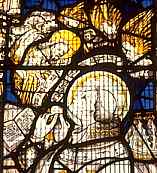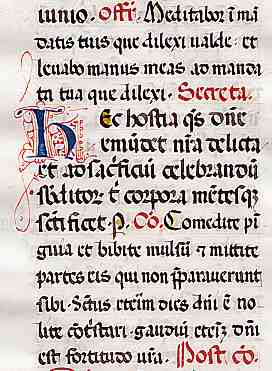 |
| The Missal |
| The central ritual of the medieval Christian liturgy was the mass, the celebration of the conversion of bread and wine into the body and blood of Christ, known as the Eucharist. Masses were celebrated daily, with special forms for Sundays and for particular church feasts. In the later middle ages, there was a proliferation of private celebration of masses, often repeated many times over, for the sake of the souls of the dead, in order to release them from their sojourn in Purgatory. |
|
| A tableau of the medieval mass set up in an elevated chapel in Gloucester Cathedral, photographed in 1988. It was quite startling to come across this when you were not expecting it! |
 |
A chantry chapel in Salisbury Cathedral. |
| The image at left shows the kind of private chantry chapel that was made for the rich and famous in the late medieval era, where masses were chanted for their souls. These were additional to the regular masses performed in the chancel of the church. |
The missal, or complete service book for the mass, developed by the process of addition and compilation that was typical of medieval literate process. The late medieval missal was a complex text, containing, as well as the core text used at every mass, all the variations which applied to the special church feasts. Those referred to as the Proper of the Time, or Proprium de Tempore, are those celebrating the events in the life of Christ, and are themselves divided into those which occur at the same time every calendar year with reference to Christmas, and those which relate to Easter, which changes its time according to the lunar calendar. In addition, there are special texts for the Proper of the Saints, or Proprium Sanctorum, which celebrate the feast days of a range of saints. This requires that the first text in the missal, as in other liturgical books, must be a calendar.
There were also certain special masses for particular occasions, and masses for the dead. |
 |
Reconstruction of the medieval basilica of St Peter in Rome. |
| There is a perception that the western medieval church was entirely centralised and authoritarian, strictly prescribing every little detail of ritual practice and belief in the church from the headquarters in Rome. This is not quite true in relation to liturgy, even the mass. |
| While the Canon of the Mass was the same everywhere, each province (or archbishopric) and in some cases individual dioceses (or bishoprics) had their own variations on the texts used for the special feasts, and could have different selections of saints honoured, often including ones of regional significance to them. This is referred to as the "use" of a particular place. As well, the newer orders of the later middle ages, such as the Dominicans and Franciscans, created their own variants. The Missale Romanum, which after the medieval period gradually became the standard text for the mass across western Catholic Christendom, was evidently derived from Franciscan usage. During the middle ages there was no single complete correct text for the missal, although all the components had to be drawn from the approved Biblical resources. |
| The mass comprised sections spoken or chanted by the priest as he conducted the ritual performance, as well as sections sung by the choir and readings conducted by the deacons. The information to be conveyed included both words and music. The segments of the mass were Introit, Collect, Epistle, Gradual and Alleluia or Tract, Gospel, Offertory, Secret, Communion and Post-Communion. These sections are identified in the missal by rubrics, usually abbreviated. |
 |
Segment from a late 12th century missal in use at the church of St Bavo, Ghent (British Library, add. ms. 16949, f.iv), by permission of the British Library. |
| In the example at left you can see the rubrics Secreta and Post Co , and yes, if that had been a colour photograph they would have been red. |
| The complete missal only became common in the later 13th century, having developed since around the 11th century from various modes of compiling the pre-existing individual texts which made up the different components of the mass. This owes as much, I think, to developing concepts of literacy and the use of the written word as an information system as it does to the increasing availability of scribes and sheepskin. Over the course of the middle ages, reliance on the formidable memories of the scholarly guardians of knowledge was overtaken by the production of written compilations which contained elaborately categorised libraries of knowledge in single volumes. The missal is often desribed as a service book, but possibly it would be more accurate to descibe it as the library of the mass, from which the individual details of each occasion could be abstracted. |
 |
Pope Gregory receives a miraculous vision during the mass, in this 15th century stained glass window in the parish church of All Saints North Street, York. |
| In this wonderful window, a book with writing is clearly visible, suggesting, as do other artistic depictions, that by this period the written word sat in the church in front of the priest at mass. But was this because the priest needed to refer to the text, or because the words themselves were part of the sacred ritual paraphernalia, and was the book a missal? |
 |
Segment from a page of a 15th century missal, from a private collection. |
| The example at left, showing the rubrics in the appropriate colour, is boldly and elegantly written. There are some corrections or annotations in a cursive hand in the margins. Apart from a noticeable greasy mark in the lower margin at the page turning point, the page is very clean and white. It looks like something which may have been used as a reference text rather than a book subjected to daily use in an atmosphere of incense and candle smoke. Admittedly, this is one little decontexted example. However, the individual books for specific components of the mass: the sacramentaries and ordinals for the priest, the lectionaries and other texts for the readings, and the gradual for the choir, did not disappear. These were more likely to be what was used by the various participants in the church. |
|
 Categories
of Works Categories
of Works |
|
 |
 |
 |
 |
 |
 |
 |





